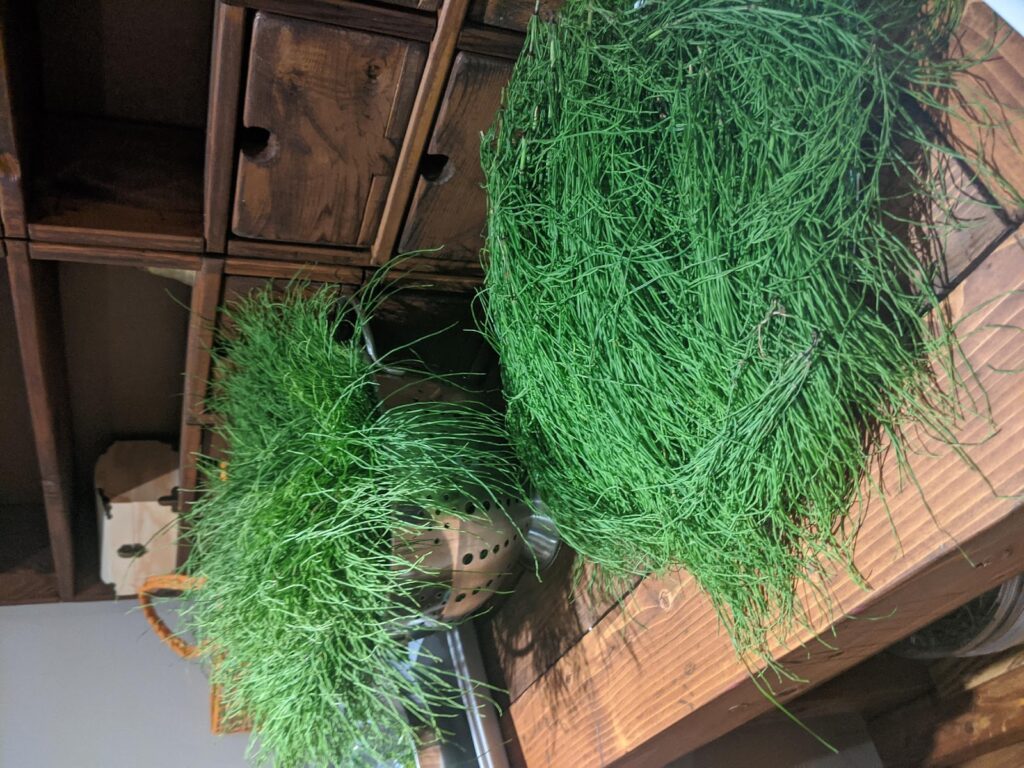“Delicate as lace, strong as stone—horsetail is one of nature’s quiet powerhouses.”
This amazing plant comes up early in Spring, first as the female part. She releases her spores and then dies. The male then springs up not too far from the female. The young fertile shoots can be picked and cooked like asparagus, however you have to act fast to pick them as they transform and grow quickly!
What Is Horsetail?
Equisetum arvense, commonly known as horsetail, is an ancient plant that’s been around since dinosaurs roamed the Earth, though it is estimated that these plants were as big as trees and were part of large forests.

Its long, brush-like stems hold a secret:
Horsetail is one of the richest plant sources of silica, a mineral essential for bone, hair, skin, and nail health.
In herbalism, horsetail is revered for its strengthening, healing, and toning properties.
Key Benefits of Horsetail
1. It strengthens bones, hair, skin, and nails: Thanks to its high silica content, horsetail supports collagen formation and mineral absorption.
2. It supports urinary tract health: It acts as a gentle diuretic, helping flush fluids and tone the bladder.
3. It aids in wound healing: When applied topically, it helps stop bleeding and its astringent nature speeds healing.
How to Use Horsetail (Link each section to another page with the description on how to make the product.)
- Horsetail Infusion (Tea): Use 1 tsp dried herb per cup of water, simmer for 10–15 minutes, and drink up to 2 cups daily for two weeks.
- Hair Rinse: Steep a strong tea, let it cool, and pour over hair to strengthen follicles.
- Poultice or Soak: Apply to wounds or sore joints traditionally for healing support.
- Hair oil treatment: Apply to hair and let soak for 20 minutes.
- Pot scrubber: It can also be used to scrub dirty pots and pans. This is great, especially when camping.
- Garden fertiliser and fungicide: Spray on your garden plants-.
Contraindications & Cautions

It is best to avoid Equisetum arvense:
- If you are pregnant or breastfeeding (unless under guidance of a qualified herbalist).
- If you have heart or kidney disease.
- Children
It should not be used over long periods internally. It is best to limit the amount of time to two weeks.
It may interact with diuretics or lithium, and it contains trace thiaminase which can reduce vitamin B1 levels in high doses.
How and when to harvest Horsetail (To verify)
Here in Quebec, the weather is a bit cooler than other areas of North America. It is therefore recommended to pick Equisetum arvense before St-Jean Baptiste Day, the 24th of June (Schneider, 20..). Afterwards, the silica level gets too high for internal use. So then, it is extremely good for scrubbing pots!
It is important to properly identify this species of horsetail as some are toxic to humans, such as Equisetum palustre.
If you are not familiar with this plant, it is best to purchase it from a reputable source.
Where to Get Horsetail
Many natural health food stores or Herbalists sell dried Equisetum arvense.

Final Thoughts
Horsetail is another reminder of how nature’s plants are our allies. When used with respect, understanding and gratitude, horsetail is an herbal ally that can support our bones, tissue healing, and urinary health. It can help us in the garden and even in doing our dishes!
Turning towards plants is a subtle yet powerful way to reconnect with the natural world. Nature has so much to offer, and it’s always here to offer support.
References
Hoffmann, David. Medical Herbalism: The Science and Practice of Herbal Medicine. Healing Arts Press, 2003.
Bone, Kerry & Mills, Simon. Principles and Practice of Phytotherapy, 2nd ed. Churchill Livingstone, 2013.
European Medicines Agency (EMA) – Equisetum arvense Herbal Monograph.
Gladstar, Rosemary. Herbal Healing for Women. Simon & Schuster, 1993.
Jugdaohsingh, R. (2007). Silicon and bone health. The Journal of Nutrition, Health & Aging, 11(2):99–110.
National Center for Biotechnology Information. Equisetum arvense. https://www.ncbi.nlm.nih.gov
Schneider, Annie (2011) Je me soigne avec les plantes sauvages. Éditions de l’homme
White, Linda B. (MD) and Foster, Steven (2000). The Herbal Drugstore; New American Library (Penguin), New York, New York.


